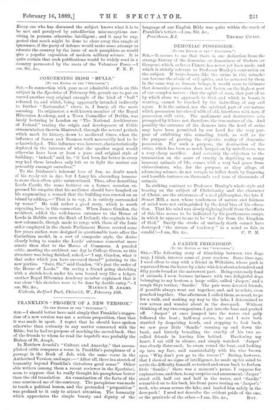CONCERNING IRISH " BULLS."
[To THE EDITOR OF THE "SPECTATOR."] SIE,—In connection with your most admirable article on this subject in the Spectator of February 9th, permit me to put on record another very original example of the kind of " bull " referred to, and which, being apparently intended indirectly to further " Nationalist " views, is, I fancy, all the more amusing. Its originator, a well-known member of the Royal Hibernian Academy, and a Town Councillor of Dublin, was lately lecturing in London on " The National Architecture of Ireland," tracing the origin and development of Celtic ornamentation therein illustrated, through the several periods which mark its history, down to mediaeval times, when the influence of Saxon and Norman work necessarily had to be acknowledged. This influence was, however, characteristically deplored in the interests of what the speaker urged would otherwise have been at least a pure and original style of building; " indeed," said he, " it had been far better in every way had these invaders only left us to fight. the matter out peaceably amongst ourselves."
To the Irishman's inherent love of fun, no doubt much of his ready wit is due, but I fancy his abounding humour is more than often quite unintentional. Thus, after describing Leeds Castle, the same lecturer on a former occasion ex- pressed his surprise that his audience should have laughed on his augmenting a remark that the building was erected on an island by adding,—" That is to say, it is entirely surrounded by water." He told rather a good story, which is worth repeating here, in this connection. When James Gandon, the architect, added the well-known entrance to the House of Lords in Dublin (now the Bank of Ireland), the capitals to his new colonnade, though made to range with those of the Ionic order employed in the classic Parliament House erected some few years earlier, were designed in questionable taste after the Corinthian model, in a sort of composite style, the desire clearly being to render the Lords' entrance somewhat more ornate than that to the House of Commons. A puzzled critic, meeting the architect one day in College Green, as this structure was being finished, asked,—" I say, Crandon, what is that order which you have executed there?" pointing to the new portico. "Sure, Sir," said Gandon, "it's just the order of the House of Lords." On seeing a friend going sketching with a sketch-book under his arm bound very like a ledger, another Royal Hibernian Academy member explained that it was clear "his sketches were to be done by double entry."—I
am, Sir, &c., MauaicE B. ADAMS. Kirkcote, Bedford Park, Chiswick, W., February 10th.






































 Previous page
Previous page